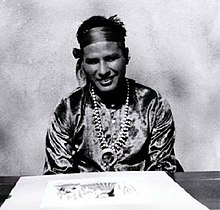Narciso Abeyta
Narciso P. Abeyta | |
|---|---|
 | |
| Born | Ha So Deh 1918 Canoncito, New Mexico, U.S. |
| Died | June 22, 1998 |
| Nationality | Navajo, American |
| Known for | Painting, silversmithing |
| Spouse | Sylvia Ann |
| Children | 7, including Pablita Abeyta, Tony Abeyta |
Narciso "Ciso" Platero Abeyta, or Ha So Deh (1918–1998) was a Navajo painter, silversmith and Navajo code talker. He is known for his colorful paintings depicting Navajo life.[1] His work is in the permanent collection of museums including the Smithsonian National Museum of the American Indian.[2]
Early life and education
Abeyta was born in 1918. He is named after his father, Narciso. His mother was Pablita.[3] He started drawing when he was eleven.[4] He attended the Santa Fe Indian School, starting in 1939. Dorothy Dunn was his teacher. Abeyta was a Golden Gloves boxer. He served in World War II in the United States Army,[5] as a code talker.[6] After he returned from service, he was unable to work for ten years due to his experiences at war.[7] Eventually, he attended the University of New Mexico. He trained under Raymond Jonson.[4]
Mid-life and career
Abeyta was primarily a painter. His paintings document Navajo life, and use brush stroke techniques that are reminiscent of Navajo rugs.[4] He had two known commissions for work as a muralist; a 1934 mural for a social science classroom in Santa Fe, New Mexico and in 1939 for Maisel's Indian Trading Post in Albuquerque, New Mexico.[8] He demonstrated painting at the 1939 San Francisco World's Fair[9]
Abeyta married Sylvia Ann, a Quaker ceramics artist.[7] They had seven children, including artists Tony Abeyta and Pablita Abeyta. The family lived in Gallup, New Mexico.[10]
Later life and legacy
Abeyta died on June 22, 1998, from a cerebral hemorrhage.[1]
His work is held in the collections of the National Gallery of Art, National Museum of the American Indian,[2] and the Museum of New Mexico.[1]
Abeyta's paintings were included the book, Southwest Indian Painting: A Changing Art (1957, University of Arizona Press) by Clara Lee Tanner.
Major exhibitions
- 1994 –Translating Navajo Worlds: the Art of Narciso (Ha-So-De) and Tony Abeyta, Wheelwright Museum of the American Indian, Santa Fe, New Mexico[11]
References
- ^ a b c "Narciso Platero Abeyta, painter of Navajo themes". Bangor Daily News. 26 June 1998. Retrieved 7 December 2013.
- ^ a b "Changeable Werewolf". National Museum of the American Indian. Retrieved 2021-02-12.
- ^ "Narciso Abeyta". Artist. AskArt. Retrieved 23 April 2017.
- ^ a b c "Narciso Platero Abeyta (1918-1998) Ha So De - Fiercely Ascending". Adobe Gallery. Retrieved 7 December 2013.
- ^ Plateau Sciences of Gallup, NM, Code Talker's Meal, wore US Army uniform
- ^ Dyer, Linda. "20th-Century Narciso Abeyta (Ha So De) Painting". Roadshow Archive. WGBH Boston. Retrieved 7 December 2013.
- ^ a b Joëlle Rostkowski (2012). Conversations with Remarkable Native Americans. SUNY Press. p. 57. ISBN 978-1-4384-4176-4.
- ^ Lester, Patrick D., The Biographical Directory of Native American Painters, SIR Publications, Tulsa, Oklahoma, 9780806199369, page 2, First edition, 1995
- ^ Samuels, Peggy; Samuels, Harold (1985). Samuel's Encyclopedia of Artists of the American West. Secaucus, N.J.: Castle. pp. 1–2. ISBN 1555210147.
- ^ June, Ana. "Tony Abeyta". Local Flavor. Archived from the original on 12 December 2013. Retrieved 7 December 2013.
- ^ Abeyta, Narciso; Tony Abeyta (1994). Translating Navajo worlds: the art of Narciso (Ha-So-De) and Tony Abeyta, January 22-May 4, 1994. Santa fe: Wheelwright Museum of the American Indian.
